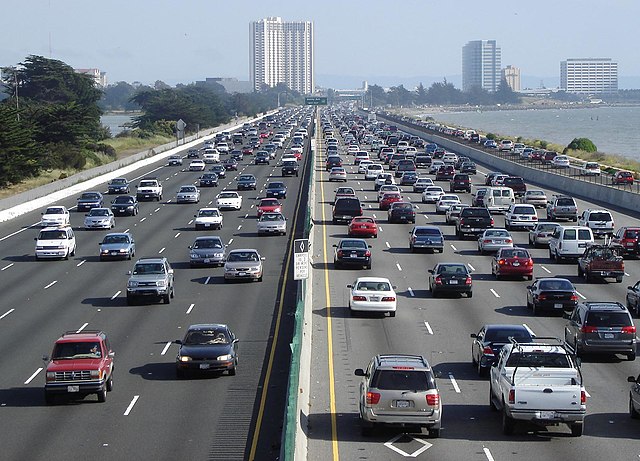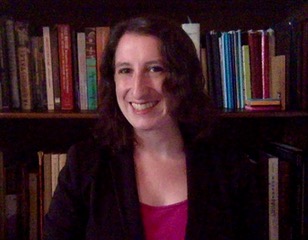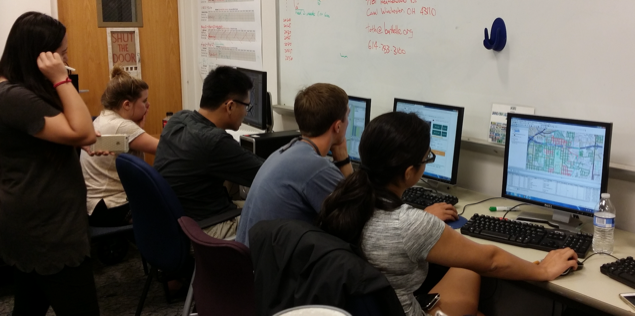
Alice Grossman is an associate research scientist in the Center for Advancing Research in Transportation Emissions, Energy, and Health at the Texas A&M Transportation Institute. She is also a science, technology, policy fellow with the Interamerican Institute for Global Change and a minority student mentor and member of two standing committees for the National Academies of Sciences Transportation Research Board. Grossman holds an undergraduate degree in physics and astronomy from Vassar and as well as a Master’s and Ph.D. in transportation from the Georgia Institute of Technology. She was a AAAS science and technology fellow, working at NOAA, in the class of 2020-21. ESAL spoke with Grossman about her work on accessible, equitable transportation.
DR: What are you researching at Texas A&M’s Transportation Institute?
Grossman: I’m just a few months in, but I’m taking the lead on part of our transportation electrification initiative. My goal is to approach it as a more holistic system, taking into account not only transportation initiatives but also energy needs for the suite of stakeholders in the transportation and energy communities. I’d like to figure out how to plan for local things like the locations of electric charging stations in a way that’s effective and equitable. For example, how do we prioritize electric vehicle charger locations in terms of existing driving behavior plus predictions for the future and equity considerations?
DR: What sorts of inputs go into that kind of planning process?
Grossman: It’s a quantitative and qualitative process that requires a fair amount of communication among stakeholders. There’s a modeling component with traditional transportation demand variables. I’m working with a startup called ElectroTempo, founded by Research Scientist Yanzhi “Ann” Xu. ElectroTempo lays utility grid information over the transportation model and includes equity analysis around statistics like household poverty levels and race. But, even when trying to build these variables into the model, you need to bring the right voices into the process.

Alice Grossman.
DR: How do you find that set of relevant voices?
Grossman: Traditional transportation planning processes direct community outreach, which can be helpful, but you run into issues of who can access the meetings or websites. Organizations that already have roots and ties in the community can also be effective for reaching people, so you try to find those connections as well. We still have huge strides to make in the transportation field in terms of understanding and planning for the mobility needs of people – especially those that are historically disenfranchised from the planning process.
DR: I’m curious about your path to transportation research from your undergrad degree in physics and astronomy.
Grossman: I was always a math and physics person growing up. I went to college knowing I wanted to be a physics major. At Vassar, physics and astronomy are housed in one building; astronomy is essentially “physics in space.” And Vassar has excellent astronomy professors and the second largest telescope in New York. With only 12 of us graduating in physics and astronomy combined per year, I got plenty of telescope time and great instruction.
DR: So, what changed your path from astronomy research?
Grossman: In college, I was also minoring in a self-made program of urban planning and architectural history. My junior year, I went abroad to Catalonia and interned at an architecture firm, which planted a seed. During college, I had also worked in a lab at U. Chicago, where groups of astronomers were spending years and years building the South Pole Telescope. As I graduated from college, I reflected on the fact that it might take seven years to do an astronomy Ph.D.; that the GRE Physics Test has unnaturally low pass rates; and that I might be better off pursuing some other path. In retrospect, I suppose I was having some imposter syndrome about going into astronomy research.
DR: So, what did you do?
Grossman: I headed back to Spain! First, I taught English and then I got another internship at a Catalan architectural firm. I stayed for a couple of years, immersed in the beautiful architecture of Catalonia, during which I became ready to apply to graduate school. You might think I would have applied to architectural school, but nope! I returned to my original interest in physics with a weave of urban design. Not knowing much about it as a field, I applied to civil engineering programs, drawn to working on the quantitative aspects of the relationship between society and built environments. Georgia Tech offered me a funded place in their Transportation Systems Engineering group, after a couple of professors noticed my application, and that’s where I landed.

Students at Georgia Tech working on data related to sidewalk usage. Photo credit: Alice Grossman.
DR: How was that as a landing spot, given your background and interests?
Grossman: I loved it! While astronomy is fascinating, it has a long time lag to discovery, and the scientific knowledge you get is incredibly important, but indirect. In transportation, you do a study recommending where to put in bike lanes relative to demand and equity – and then you see a municipality literally paint that lane on the road. Your impacts are direct and visible. In graduate school, I did my Master’s on sidewalk asset management and inventory in relation to ADA accessibility. Atlanta’s 2018 City Transportation Plan ended up including a map of the data that I had physically collected with the help of masters and undergraduate students.
DR: What about your Ph.D. research?
Grossman: I looked at the impacts of federal policies on how transportation planners were using quantitative data. So, it was a bit less on the ground, but drew on my interest in strengthening the use of quantitative data in conjunction with qualitative assessments. Until 2012, metropolitan planning organizations were allowed to rely solely on qualitative analyses, with both short and long-term implications on funding and project delivery.
DR: What about equity issues, which I know have been another major theme of your work?
Grossman: Recently, departments of transportation have created new positions of Equity Directors and we need antiracism in the transportation field. The field of transportation has such a bad history with negative impacts on minority populations that if you work in this field, you should help rectify it. For example, in the 1950s-60s, Black neighborhoods were bulldozed to make room for highways, such as how Robert Moses worked in New York, so that white people could better access areas they wanted, while Black people were isolated. Secretary Pete Buttigieg is spearheading work to reconnect communities, providing more access to those that are stuck between highway and railroad lines. Equity will also be a major consideration in planning for transportation electrification, and I’m looking forward to helping create more equitable access to mobility, energy, and clean air.
DR: How would you recommend others get engaged in making a difference in these equity issues?
Grossman: Scientists shouldn’t be afraid to take less traditional paths to get engaged with making a difference in their communities. Just because someone hasn’t taken what might be seen as a direct path, doesn’t mean that you have to eschew it. There are always transferable skills, and taking them into the setting you care about most can make your life more interesting and improve quality of life for others. I believe strongly in interdisciplinary work because people gain different perspectives and work together to solve problems. The exchanges of ideas and knowledge that result are better for society.
Do you have a story to tell about your own local engagement or of someone you know? Please submit your idea here , and we will help you develop and share your story for our series.